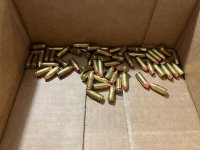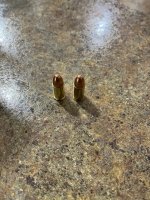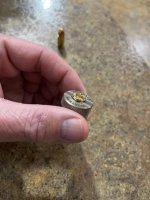Miracle Man
US Veteran
So I ordered a Hornady 9mm plunk tester and got it couple days ago. I decided to test her out and see what's up.
I had 6 boxes mostly full of previously reloaded 9mm. Couple boxes115 gr XTP's 1 box Hornady HAP and 3 boxes 115 gr FMJ. Say 250 rounds. These were loaded using LEE 9mm carbide die set.Here's what wouldn't seat:

About 65 rds.
I also recently purchased a Redding 9mm taper crimp die and loaded 2 boxes of 115 gr FML using it. Here's what wouldn't seat:

2 out of 100
And several of the rounds using Lee dies were not even close to seating:

I noticed both the rounds that wouldn't seat using Redding crimp die have rough spots around the edge of rim. And they can be seated using slight pressure.
But man as pic shows several of the reloads using the Lee crimp die are BAD. (I'm not bashing Lee dies, I probably didn't have it set up right.
I guess I have the Redding crimp die spot on. Now to try them in my new Sig P365
I had 6 boxes mostly full of previously reloaded 9mm. Couple boxes115 gr XTP's 1 box Hornady HAP and 3 boxes 115 gr FMJ. Say 250 rounds. These were loaded using LEE 9mm carbide die set.Here's what wouldn't seat:

About 65 rds.
I also recently purchased a Redding 9mm taper crimp die and loaded 2 boxes of 115 gr FML using it. Here's what wouldn't seat:

2 out of 100
And several of the rounds using Lee dies were not even close to seating:

I noticed both the rounds that wouldn't seat using Redding crimp die have rough spots around the edge of rim. And they can be seated using slight pressure.
But man as pic shows several of the reloads using the Lee crimp die are BAD. (I'm not bashing Lee dies, I probably didn't have it set up right.
I guess I have the Redding crimp die spot on. Now to try them in my new Sig P365
